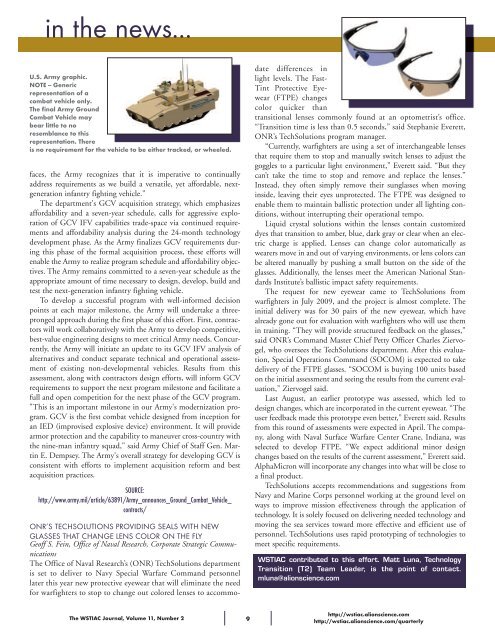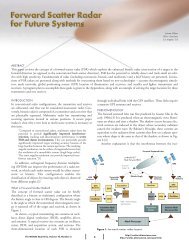Comparing Blast Pressure Variations of Lead Primers - Weapon ...
Comparing Blast Pressure Variations of Lead Primers - Weapon ...
Comparing Blast Pressure Variations of Lead Primers - Weapon ...
You also want an ePaper? Increase the reach of your titles
YUMPU automatically turns print PDFs into web optimized ePapers that Google loves.
in the news...<br />
U.S. Army graphic.<br />
NOTE -- Generic<br />
representation <strong>of</strong> a<br />
combat vehicle only.<br />
The final Army Ground<br />
Combat Vehicle may<br />
bear little to no<br />
resemblance to this<br />
representation. There<br />
is no requirement for the vehicle to be either tracked, or wheeled.<br />
faces, the Army recognizes that it is imperative to continually<br />
address requirements as we build a versatile, yet affordable, nextgeneration<br />
infantry fighting vehicle."<br />
The department's GCV acquisition strategy, which emphasizes<br />
affordability and a seven-year schedule, calls for aggressive exploration<br />
<strong>of</strong> GCV IFV capabilities trade-space via continued requirements<br />
and affordability analysis during the 24-month technology<br />
development phase. As the Army finalizes GCV requirements during<br />
this phase <strong>of</strong> the formal acquisition process, these efforts will<br />
enable the Army to realize program schedule and affordability objectives.<br />
The Army remains committed to a seven-year schedule as the<br />
appropriate amount <strong>of</strong> time necessary to design, develop, build and<br />
test the next-generation infantry fighting vehicle.<br />
To develop a successful program with well-informed decision<br />
points at each major milestone, the Army will undertake a threepronged<br />
approach during the first phase <strong>of</strong> this effort. First, contractors<br />
will work collaboratively with the Army to develop competitive,<br />
best-value engineering designs to meet critical Army needs. Concurrently,<br />
the Army will initiate an update to its GCV IFV analysis <strong>of</strong><br />
alternatives and conduct separate technical and operational assessment<br />
<strong>of</strong> existing non-developmental vehicles. Results from this<br />
assessment, along with contractors design efforts, will inform GCV<br />
requirements to support the next program milestone and facilitate a<br />
full and open competition for the next phase <strong>of</strong> the GCV program.<br />
"This is an important milestone in our Army's modernization program.<br />
GCV is the first combat vehicle designed from inception for<br />
an IED (improvised explosive device) environment. It will provide<br />
armor protection and the capability to maneuver cross-country with<br />
the nine-man infantry squad," said Army Chief <strong>of</strong> Staff Gen. Martin<br />
E. Dempsey. The Army's overall strategy for developing GCV is<br />
consistent with efforts to implement acquisition reform and best<br />
acquisition practices.<br />
SOURCE:<br />
http://www.army.mil/article/63891/Army_announces_Ground_Combat_Vehicle_<br />
contracts/<br />
ONR’S TECHSOLUTIONS PROVIDING SEALS WITH NEW<br />
GLASSES THAT CHANGE LENS COLOR ON THE FLY<br />
Ge<strong>of</strong>f S. Fein, Office <strong>of</strong> Naval Research, Corporate Strategic Communications<br />
The Office <strong>of</strong> Naval Research’s (ONR) TechSolutions department<br />
is set to deliver to Navy Special Warfare Command personnel<br />
later this year new protective eyewear that will eliminate the need<br />
for warfighters to stop to change out colored lenses to accommo-<br />
The WSTIAC Journal, Volume 11, Number 2 9<br />
date differences in<br />
light levels. The Fast-<br />
Tint Protective Eyewear<br />
(FTPE) changes<br />
color quicker than<br />
transitional lenses commonly found at an optometrist’s <strong>of</strong>fice.<br />
“Transition time is less than 0.5 seconds,” said Stephanie Everett,<br />
ONR’s TechSolutions program manager.<br />
“Currently, warfighters are using a set <strong>of</strong> interchangeable lenses<br />
that require them to stop and manually switch lenses to adjust the<br />
goggles to a particular light environment,” Everett said. “But they<br />
can’t take the time to stop and remove and replace the lenses.”<br />
Instead, they <strong>of</strong>ten simply remove their sunglasses when moving<br />
inside, leaving their eyes unprotected. The FTPE was designed to<br />
enable them to maintain ballistic protection under all lighting conditions,<br />
without interrupting their operational tempo.<br />
Liquid crystal solutions within the lenses contain customized<br />
dyes that transition to amber, blue, dark gray or clear when an electric<br />
charge is applied. Lenses can change color automatically as<br />
wearers move in and out <strong>of</strong> varying environments, or lens colors can<br />
be altered manually by pushing a small button on the side <strong>of</strong> the<br />
glasses. Additionally, the lenses meet the American National Standards<br />
Institute’s ballistic impact safety requirements.<br />
The request for new eyewear came to TechSolutions from<br />
warfighters in July 2009, and the project is almost complete. The<br />
initial delivery was for 30 pairs <strong>of</strong> the new eyewear, which have<br />
already gone out for evaluation with warfighters who will use them<br />
in training. “They will provide structured feedback on the glasses,”<br />
said ONR’s Command Master Chief Petty Officer Charles Ziervogel,<br />
who oversees the TechSolutions department. After this evaluation,<br />
Special Operations Command (SOCOM) is expected to take<br />
delivery <strong>of</strong> the FTPE glasses. “SOCOM is buying 100 units based<br />
on the initial assessment and seeing the results from the current evaluation,”<br />
Ziervogel said.<br />
Last August, an earlier prototype was assessed, which led to<br />
design changes, which are incorporated in the current eyewear. “The<br />
user feedback made this prototype even better,” Everett said. Results<br />
from this round <strong>of</strong> assessments were expected in April. The company,<br />
along with Naval Surface Warfare Center Crane, Indiana, was<br />
selected to develop FTPE. “We expect additional minor design<br />
changes based on the results <strong>of</strong> the current assessment,” Everett said.<br />
AlphaMicron will incorporate any changes into what will be close to<br />
a final product.<br />
TechSolutions accepts recommendations and suggestions from<br />
Navy and Marine Corps personnel working at the ground level on<br />
ways to improve mission effectiveness through the application <strong>of</strong><br />
technology. It is solely focused on delivering needed technology and<br />
moving the sea services toward more effective and efficient use <strong>of</strong><br />
personnel. TechSolutions uses rapid prototyping <strong>of</strong> technologies to<br />
meet specific requirements.<br />
WSTIAC contributed to this effort. Matt Luna, Technology<br />
Transition (T2) Team <strong>Lead</strong>er, is the point <strong>of</strong> contact.<br />
mluna@alionscience.com<br />
http://wstiac.alionscience.com<br />
http://wstiac.alionscience.com/quarterly




